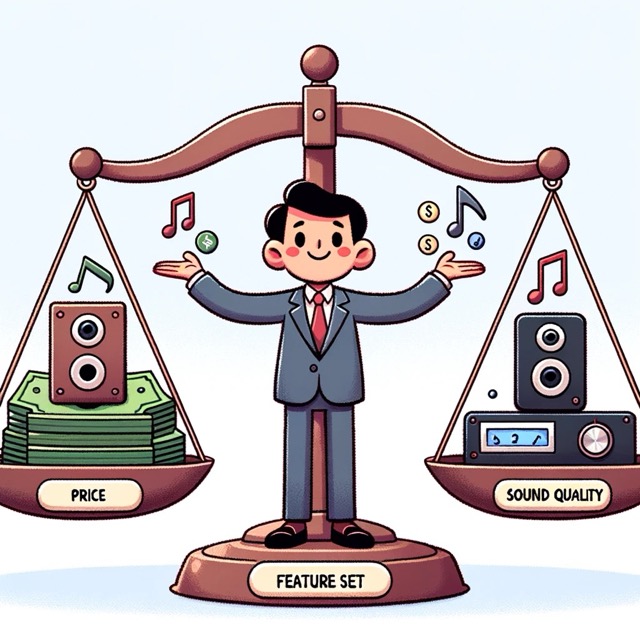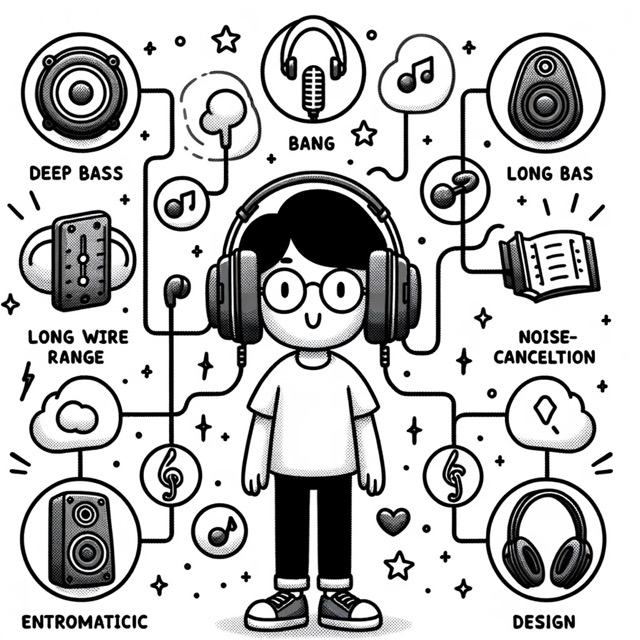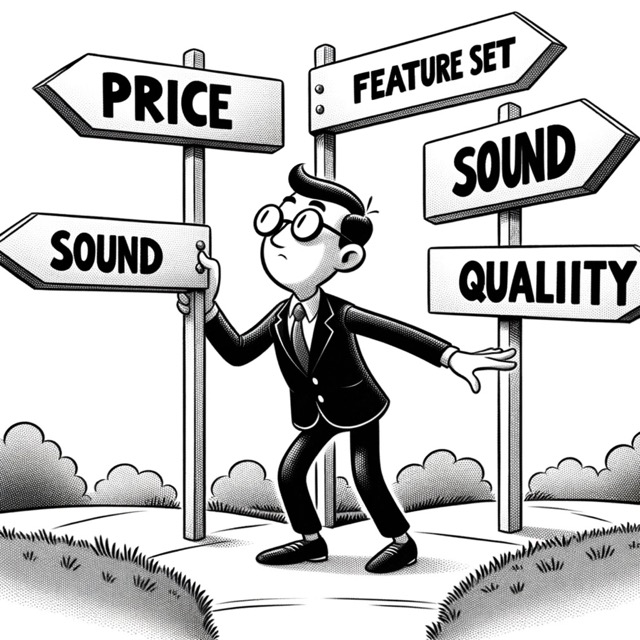Audio quality == Price == Features
Finding the right balance between audio quality, price and feature sets in audio products is the primary mission of this website:

Audio Quality and Measurements
I am firm believer that measurements can tell you almost everything about the audio that ultimately reaches your ears, but crucially not everything. I am a big fan of AudioScienceReview and Amir and others there have thought me so much over of the past few years and then books like Floyd O’Toole Sound Reproduction are incredibly revelatory and easy to read for anyone interested in audio quality.
But Audio is still complex and rating a device is not as simple as one or 2 metric values in a chart. In some cases the real revelatory measurements you would need are either too expensive or too awkward to capture, for example, a personal HRTF (Head Related Transfer Function) measurement for a headphone as that can have a massive effect on the sound you hear from headphones and IEM’s.
Also with IEM’s and Headphones Measurements are usually not accurate above the 8Hz region so that upper treble “air” can be elusive and is often called “technicalities” by experienced audio reviewsers. And for speakers obviously the Room has a huge affect on what someone hears below 400hz so while measurements are way better than subjective opinions, there will be times where you own ears are much more accurate.
This means graphs will not tell you exactly how specific devices like headphones and IEM’s are going to sound for you and you should always trust your ears but with a little knowledge and a few pragmatic choices you can get a greater understanding of your own personal preferences and get you 90% of the way to great sound.
Chasing audio quality down the rabbit hole
 From a purely pragmatic approach to audio, it cannot always be about chasing that the final 0.001% of quality, this is especially true when we know that we cannot hear certain frequencies why go for 96khz when nobody can hear beyond 20khz (therefore with the Nyquist theorem CD quality of 44Khz is more than enough for everyone ) and that from extensive A/B testing has shown that at certain levels we (or 99% of us without “golden ears”) cannot tell the difference between say a 320kpbs MP3 and a CD quality FLAC file or tell a $100 DAC from a $1000 DAC.
From a purely pragmatic approach to audio, it cannot always be about chasing that the final 0.001% of quality, this is especially true when we know that we cannot hear certain frequencies why go for 96khz when nobody can hear beyond 20khz (therefore with the Nyquist theorem CD quality of 44Khz is more than enough for everyone ) and that from extensive A/B testing has shown that at certain levels we (or 99% of us without “golden ears”) cannot tell the difference between say a 320kpbs MP3 and a CD quality FLAC file or tell a $100 DAC from a $1000 DAC.
Having this knowledge should allow even the most audio quality obsessed person can appreciate that comparing 2 products that an inaudibile different from than each other, the cheaper one is more pragmatic one though the more expensive one might satisfy a more irrational need.
For reference there is an excellent thread on Audio Science Review -> Are Measurements everything or nothing
I believe all the following measurable attributes of an audio device affect the sound quality and where possible should be measured and that knowledge should be shared:
Frequency Response
 This is the most obvious one and important measurement especially with transducers (i.e. Speakers, Headphones) were a good “flat” response should be aimed for and then personal preference (a bass boost) should then be applied.
This is the most obvious one and important measurement especially with transducers (i.e. Speakers, Headphones) were a good “flat” response should be aimed for and then personal preference (a bass boost) should then be applied.
Of course certain music might be recorded with badly tuned equipment leading to the “Circle of confusion” in audio, but the extensive research done by Harman over the years would indicate that we can find an average “reference frequency response curve” for speakers, headphones and IEM’s, one that suits the majority of people for the majority of recordings and genres.
Once we can get this reference curve the majority of people listening to the majority of recorded music should hear an “ideal” tonality to their music. Personal preference and individual recordings or music genres will mean that tone controls or ideally EQ / DSP should be part of every audio lovers “toolbox”.
I firmly believe that DSP using PEQ is the future for all audio allowing clever software to restore an appropriate tonality to the freqency response even to poorly tuned devices.
Power / SPL / Volume
Sadly audio manufacturers continue to exaggerate the capabilities of their devices and it can be very difficult to know if a particular device will have enough power (SPL) in your room or have enough power to drive your headphones. This can be further complicated because if you like deep bass you will need more power, the basic rule of thumb is get lots of “headroom”. Similar to buying a car it is better to have more power in case you need it on occasion than not have the power.
Distortion / Noise
This is closely associated with the power above, but driving a transducer too far will introduce signifiant distortion into your audio, sometimes this is masked by the music itself but it is better to know reduce the likelihood of distortion. Also, products like DAC and Streamers which will be earily in your audio workflow (before the amplifier and speakers) should ideally have very minimal noise and distortion and this is where the SINAD scores championed by AudioScienceReview are good indicators as a small amount of noise from a DAC will get amplified by your amplifier or will cause your DSP componnet to be less effective (less bits to deal with).
Cross talk
Stereo is still our main way of listening to music (though as someone with a nice Dolby Atoms setup I cannot wait for good sounding “spatial audio” recordings that are more than just “demos”). So for me to appreciate that stereo image we want to minimize any chance of cross talk being introduced (unless we want the effect for example when listening to concert it might provide a nice effect)
Channel Mismatch
I believe this is less of a problem but when looking for cheaper but good sounding devices like IEM’s it can be a problem probably in the manufacturing process difference in the left and right channel were introduced. For example, I received a Truthear Zero (which is a great pragmatic IEM) but I could see (and then hear) that the left ear was incorrectly set causing stereo imagining problems.
Unit variations
This is similar to the channel mismatch above but often especially when speakers and headphones are manufacturer over many years the can be variations, due to different factories or slightly different components being used in different batches. So it’s important to realise that a published Frequency Response might be from a different batch than yours, so if it doesn’t sound correct even after EQ to you either return the device or tweak the EQ to your preference.
Why Price
I hope this is obviously but unless you are a millionaire the audio hobby can be very expensive, so finding good sounding and good features at a good price is by definition pragmatic.

As this cartoon shows sometimes the budget is as good as the premium offering or at least similar enough not to be audibly different.
Why Features
I believe you can both have too many and having missing features on a product. Most AVR are examples of products with too many features and chasing features usually ( though not always e.g. Denon AVR’s ) mean sound quality can suffer.
So finding the right set of features in a product are vital. Often in audio there are “snake oil” features which might seem great but reality have no effect on the sound.

For example, do you really need MQA support in a DAC, if you feel you do then great go for it, but if having one less feature that you might not want means the same audio quality yet a cheaper price then that has to be pragmatic.
Since they are often related I have bundled “build quality” and product design as features and when appropriate I will mention both when discussing products.
Understanding Pragmatic audio
Allow Pragmatic Audio to find the right products for you:

I will attempt in this website to highlight audio products that have this appropriate balance between sound quality, price, and an appropraite features set. I believe once this balance is made anyone can have fantastic audio experiences.
I hope to provide pragmatic reviews of audio products which will balance these 3 concerns to allow anyone make an informed decisions.
I will also upload measurements to the appropriate websites and also provide a Pragmatic Audio Squig Database
Mission Statement
From headphones and speakers, to amplifiers, streamers and especially DSP based products, I will provide articles and product reviews with the necessarily details and no “audiophile” snake oil.
Welcome to Pragmatic Audio, where quality sound meets sensible spending.
What to expect
Product Reviews Detailed reviews and comparisons of audio equipment like microphones, headphones, audio interfaces, monitors, etc. This could be especially useful for users who are looking to purchase new equipment and want an honest, pragmatic assessment.
Music Reviews I will review some great music to play on your new audio purchases.
Articles: Some original Articles but also links to interesting and worthwhile posts on other websites, or podcasts discussing the latest trends in the audio industry. This could include new technologies, software updates, new techniques, or changes in the industry.
Guides: Practical guides on different aspects of audio technology or sound design. These could range from beginner guides to very experienced. I have a passion about DSP so expect lots good material related to DSP.
Resources and Tools: A list of useful resources and tools for audio professionals and enthusiasts. This might include software recommendations, tutorials, links to online courses, and more.
Note: I am not associated with the youtube channel “Pragmatic Audio Reviews” which mainly review IEM’s - but obviously they choose a great name for their channel